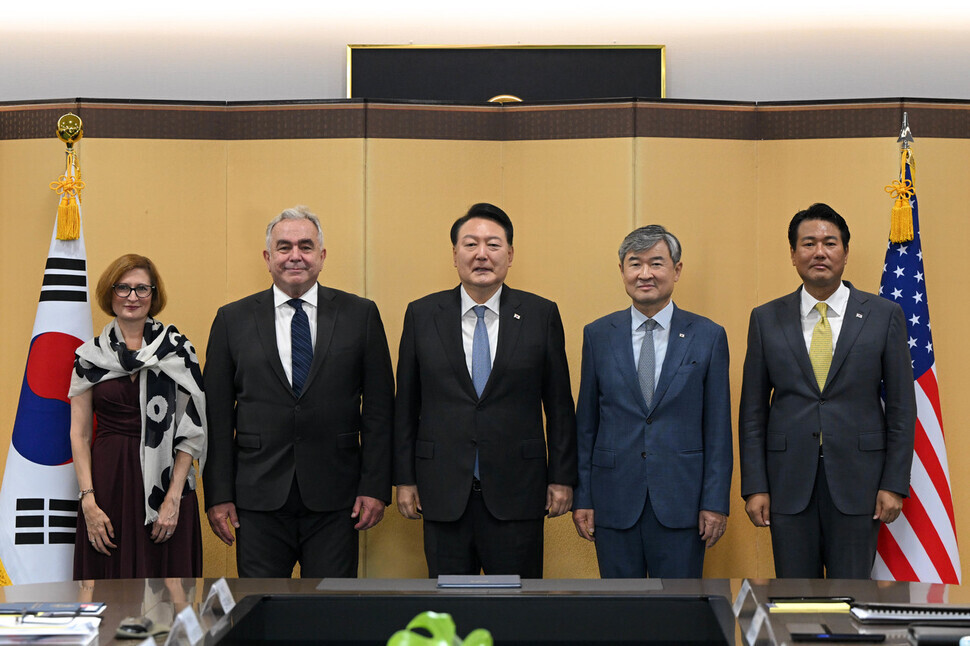hankyoreh
Links to other country sites 다른 나라 사이트 링크
Nuclear-capable US sub arrives in Busan as S. Korea, US hold first Nuclear Consultative Group talks

South Korea and the US convened their first meeting of the Nuclear Consultative Group (NCG) in Seoul on Tuesday, after which they asserted that the two countries “will move towards combined deterrence in which both countries will decide and act together.”
The two countries also revealed that the USS Kentucky, an Ohio-class nuclear-powered ballistic missile submarine capable of carrying nuclear weapons, arrived at the Busan naval base for the first time in 42 years. This is the first deployment of this type of American submarine to the Korean Peninsula since the Cold War, and is expected to increase tensions on the peninsula.
A joint statement was released after the inaugural NCG meeting between Kim Tae-hyo, the first deputy director of the South Korean National Security Office; Kurt Campbell, coordinator for Indo-Pacific affairs at the White House National Security Council; and Cara Abercrombie, National Security Council coordinator for defense policy and arms.
“Any nuclear attack by North Korea against the United States or its allies is unacceptable and will result in the end of that regime, and the US and ROK sides highlighted that any nuclear attack by the DPRK against the ROK will be met with a swift, overwhelming, and decisive response,” the statement read.
The inaugural NCG meeting “afforded the United States an opportunity to reaffirm and strengthen the US commitment to provide extended deterrence to the ROK backed by the full range of US capabilities, including nuclear,” the statement read.
Extended deterrence is the concept that in the event of a nuclear attack on an ally, the US would use tactical nuclear weapons to retaliate and punish a country that attacks an ally to the same degree as if the US itself were attacked.
“Both sides affirmed that the NCG will play an integral role in discussing and advancing bilateral approaches, including guidelines, to nuclear and strategic planning and responses to DPRK aggression,” South Korea and the US said in the readout.
The two countries also added that they have established a number of “workstreams” to strengthen nuclear deterrence and response capabilities on the Korean Peninsula, including the development of security and information-sharing procedures, nuclear consultation and communication systems during crises and contingencies; and cooperation and development of relevant planning, operations, exercises, simulations, training, and investment activities.
As a result of their summit in April, South Korean President Yoon Suk-yeol and US President Joe Biden signed the Washington Declaration, which established the Nuclear Consultative Group and pledged to regularly deploy US strategic assets, including nuclear submarines, to the Korean Peninsula.
South Korea and the US announced after the press briefing on Tuesday that the US Ohio-class nuclear-powered ballistic guided missile submarine USS Kentucky entered the Busan operating area for the first time in 42 years, its last visit being in 1981.
“As we speak an American nuclear submarine is making port in Busan today. It’s the first visit of an American nuclear submarine in decades,” Campbell said at the press conference, calling it a clear statement that shows its intent to keep nuclear deterrence strong and credible through a series of activities.
The US is demonstrating its commitment to extended deterrence in action. The Defense Ministry also issued a press release confirming the USS Kentucky’s arrival in Busan.
“Today, we’ve gained confidence that South Korea and the US will be able to sufficiently and decisively strengthen extended deterrence to a degree where the need for independent nuclear armament becomes unnecessary,” Kim stated, reaffirming South Korea’s stance that there is no need for the country to develop its own nuclear weapons.
By Kim Mi-na, staff reporter
Please direct questions or comments to [english@hani.co.kr]

Editorial・opinion
![[Column] Tariffs on China: Trump was dumb, Biden dumber [Column] Tariffs on China: Trump was dumb, Biden dumber](https://flexible.img.hani.co.kr/flexible/normal/500/300/imgdb/original/2024/0520/191716191153918.jpg) [Column] Tariffs on China: Trump was dumb, Biden dumber
[Column] Tariffs on China: Trump was dumb, Biden dumber![[Column] What if Seoul took reunification by force off the table? [Column] What if Seoul took reunification by force off the table?](https://flexible.img.hani.co.kr/flexible/normal/500/300/imgdb/original/2024/0520/3017161928630494.jpg) [Column] What if Seoul took reunification by force off the table?
[Column] What if Seoul took reunification by force off the table?- [Editorial] Intensifying US-China rivalry means Seoul must address uncertainty with Beijing sooner than later
- [Column] When ‘fairness’ means hate and violence
- [Editorial] Yoon must stop abusing authority to shield himself from investigation
- [Column] US troop withdrawal from Korea could be the Acheson Line all over
- [Column] How to win back readers who’ve turned to YouTube for news
- [Column] Welcome to the president’s pity party
- [Editorial] Korea must respond firmly to Japan’s attempt to usurp Line
- [Editorial] Transfers of prosecutors investigating Korea’s first lady send chilling message
Most viewed articles
- 1Xi, Putin ‘oppose acts of military intimidation’ against N. Korea by US in joint statement
- 2Kim Jong-un wanted to meet with residents of shelled Yeonpyeong Island in South, Moon recalls in mem
- 3To weigh costs and benefits, Korea must stop treating US troop presence as a sacred cow
- 4Berlin mayor hints at tearing down ‘comfort women’ memorial in city
- 5[Column] What if Seoul took reunification by force off the table?
- 6[Column] Tariffs on China: Trump was dumb, Biden dumber
- 7For new generation of Chinese artists, discontent is disobedience
- 8[Exclusive] Truth commission to seek additional murder charges for figures behind 1980 Gwangju massa
- 9China, Russia put foot down on US moves in Asia, ratchet up solidarity with N. Korea
- 10Putin’s trip to China comes amid 63% increase in bilateral trade under US-led sanctions